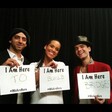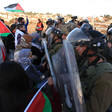The Electronic Intifada 6 June 2014

The New York Times is aligning itself with Israel’s attempts at decoupling Palestinian and Christian identity.
APA imagesThe New York Times’ coverage of the Pope’s recent visit to the Middle East demonstrates yet another facet of how the US’ most important media outlet obfuscates Palestinian identity and realities and misinforms the public on Palestine.
In seven news articles about the Pope’s visit by Jodi Rudoren and Isabel Kershner totaling 9,000 words, the paper fails to mention even once, or to even hint at, the existence of Palestinian Christians, despite their very significant presence in the towns that the Pope visited — Bethlehem, Jerusalem, and even in Amman, Jordan — and Palestinian Christians’ intense interest in the Pope’s visit.
Ironically, the single instance in seven articles in which The Times acknowledges the existence of an Arab Christian signals another key category of obfuscation of Palestinian identity employed by their news reporters (“Seeking balance on Mideast visit, Pope pleases few,” 21 May 2014).
The Times typically prefers not to recognize Palestinian citizens of Israel. So in one instance in the seven articles, Rudoren and Kershner identify a Palestinian Christian citizen of Israel as “an Israeli Arab and a Christian,” despite Rudoren’s own acknowledgement in a 2012 article that “most now prefer Palestinian citizens of Israel” (“Service to Israel tugs at identity of Arab citizens,” 12 July 2012).
Through careful avoidance of the phrases “Palestinian Christian” and “Palestinian citizen of Israel,” The New York Times’ coverage of the Pope’s visit collapses and simplifies Palestinian identity, and reinforces the impression that the Palestinian people are exclusively Muslims who live in the West Bank and Gaza Strip.
This framing by The Times obscures the more complex reality that Palestinians are both Muslims and Christians, who live in the Israeli-occupied West Bank and Gaza Strip, but who also live within Israel and as refugees in the diaspora in places including Amman.
The Times’ framing pits Israel in a conflict with Palestinian Muslims in the West Bank and Gaza Strip, wittingly or unwittingly supporting Israeli efforts to divide and rule the Palestinian people. The paper’s framing ignores the way many Palestinians view their own situation — as a people facing systematic discrimination by Israel, whether they live in the occupied West Bank and Gaza, within Israel or as refugees in the diaspora.
Falsehood
The Times’ framing, which targets a US audience including many who hold stereotypes about Arabs and Muslims, also perpetuates the falsehood that Israelis and Palestinians are engaged in a religious conflict, rather than a conflict resulting from decades of Israeli ethnic cleansing, military occupation and discrimination.
Analysis of the seven articles reveals systematic choices by the paper. The Times notes the Pope’s participation in five events, but remarkably never once mentions that among the hundreds — and in some instances thousands — of attendees at these five events with the Pope were large numbers of Arab Christians.
For example, on 24 May, The Times reported on a Catholic Mass at a stadium in Amman with a communion for “1,000 schoolchildren,” covered a palace ceremony with Jordan’s king and “200 diplomats and Christian dignitaries” and wrote about an event at a national park on the Jordan River — without indicating anything about the attendees themselves.
And in a 25 May article, The Times describes the Pope leading “a spirited Mass in a crowded Manger Square” in Bethlehem, with no mention of who made up the crowd. The next day, the paper reported that the Pope celebrated an “intimate mass” in the Cenacle in Jerusalem, again with no explanation of who else was at the mass. Uneducated readers were likely left confused, perhaps guessing the attendees were American and European Christians visiting the Holy Land.
Never identified
Palestinian Christians who are quoted in the articles commenting on the Pope’s visit are never identified as both Palestinian and Christian. Jamal Khadar is called the “head of a West Bank seminary and a spokesman for the pope’s visit,” Issa Kassissieh is identified as “the Palestinian ambassador to the Holy See,” and in the same article, Hanan Ashrawi is labeled a representative “of the Palestine Liberation Organization’s executive committee.”
Taken individually, the failure to identify Arab Christians at an event or in a quotation is of little significance, nor is it always necessary. However, Arab Christians’ almost total absence from all seven articles about the visit of a pre-eminent Christian leader to the Middle East adds up to a glaring omission, attributable either to laziness, insensitivity or design.
On top of leaving out the Palestinian identity of the single “Arab” Christian noted in the seven articles, a second pre-visit article includes another unidentified Palestinian citizen of Israel, Mazen Ghanaim — the mayor of Sakhnin, in the northern Galilee — in a discussion about “Israel’s Arab citizens” (“As Pope’s visit nears, hate crimes a concern in Israel,” 19 May 2014).
But “Arab Israelis,” as The Times and the Israeli government prefer to call them, share the same families, culture and history as Palestinians living in the occupied West Bank and Gaza. They are only divided by Israeli boundaries and prefer to be identified as “Palestinian citizens of Israel” as Rudoren noted in 2012, to indicate that shared identity, as well as the shared oppression by Israel of the indigenous non-Jewish population.
Shoddy
Other mainstream coverage of the Pope’s visit reveals what The New York Times did not. The Boston Globe reported that Christians in Jordan are “prominent in the economic and political elite,” and that “the overwhelming majority of the Catholic population in the Holy Land is Arab and Palestinian … The previous Latin Patriarch of Jerusalem, Michele Sabbah, was a Palestinian, and the incumbent, Fouad Twal, is a Jordanian with deep affinity for the Palestinian experience” (“Francis invites Palestinian, Israeli leaders to meet,” 25 May 2014).
The Daily Beast explained that the mass at Manger Square was “attended by thousands of Palestinian Christians,” and Israel’s normally right-wing Jerusalem Post interviewed many Palestinian Christians who attended.
The Los Angeles Times quoted Yousef Daher, “a Palestinian Christian from Jerusalem, who helped organize the papal visit to Bethlehem.”
The Wall Street Journal ran a long story about Arab Christians, and noted some of the problems faced by Palestinian Christians in Bethlehem. Al Jazeera America noted some of the Israeli restrictions on Palestinian Christians’ attendance at the events with the Pope.
The Times has received plenty of criticism in the past for the paper’s reporting on Israel and the Palestinians, including repeated problems in coverage of the Nakba ( the forced expulsion of Palestinians from their homeland leading up to and after the establishment of the State of Israel in 1948), former bureau chief Ethan Bronner’s numerous conflicts of interest, reporter Isabel Kershnar’s conflict of interest, current reporter Jodi Rudoren’s insensitivity to Israeli violence against Palestinians in Gaza, The Times’ compliance with an Israeli gag order and reliance on Israeli military sources, and the rejection of a commissioned video documentary on racism against Africans in Israel (later published by The Nation magazine and republished on The Electronic Intifada).
There is a history of the Israel lobby in the United States working to mobilize Christian support at the expense of the majority of Israel’s own Christian citizens — who are Palestinian. In a 60 Minutes television segment on CBS in 2012, then Israeli ambassador to the US Michael Oren took the liberty of speaking for Palestinian Christians, who in turn countered his very assertions on the same segment.
The Israeli government, and elements within it, have recently attempted to introduce legislation stipulating that Palestinian Christians are “not Arab” (therefore not Palestinian), and to push Palestinian Christian citizens of Israel to serve in the Israeli military.
Ultimately, what is most dangerous about The New York Times’ shoddy journalism is that, whether intentionally or not, the paper is aligning itself with Israel’s attempts at decoupling Palestinian and Christian identity.
Patrick Connors is a member of Adalah-NY: The New York Campaign for the Boycott of Israel.
Andrew Kadi is a human rights activist and digital media specialist currently serving on the Steering Committee of the US Campaign to End the Israeli Occupation.





Comments
Christians of Palestine
Permalink Yasmine replied on
I would be happy to share my recent film "The Stones Cry Out" with Jodi Rudoren and Isabel Kershner or anyone at the New York Times for that matter. They could spend an hour listening to what the Christians of Palestine tell us!!
Palestinian Christians
Permalink William Roberts replied on
And I put together for the churches here in Canada a sermon for distribution entitled, "Seven Gifts We Receive from our Brothers and Sisters Christians in Palestine". I'd be please to send it to you and the NY Times>>
Palestinian Christians
Permalink TimesWarp replied on
Very good analysis. Thanks for doing this article. Another commentary on the NY Times' reporting of Christians in Palestine can be found at this post on TimesWarp.org: http://wp.me/p3zcQt-65 ("It's Not Just the Crazies") It notes that in its reporting of the pope's visit, the Times ignored Israel's institutionalized discrimination against Christians. It tried to blame any anti-Christian incidents on extremists and omitted any mention of such incidents as the state actions against Palestinian Christian pilgrims at Easter, when Israeli police blocked worshippers (including a UN official) from visiting the Church of the Holy Sepulchre.
This is an excellent piece of
Permalink maggie replied on
This is an excellent piece of writing but it is preaching to the choir if it remains only here. This should be submitted to the New York Times for publication. It needs wider distribution so that Americans will know these facts.
Why look in the US?
Permalink J replied on
Why are we criticizing them while almost every single paper/outlet/story in our own region doesn't celebrate Arab Christians?
There's nothing sadder than hearing someone say
"اللهم ارحم موتى المسلمين في فلسطين".
And this is not a rare or isolated occurrence.